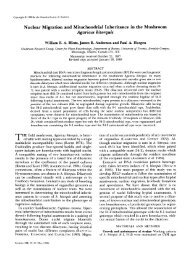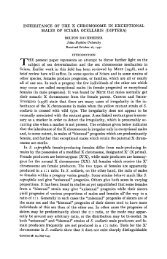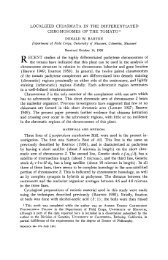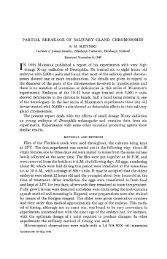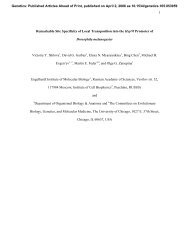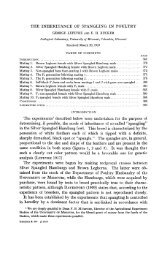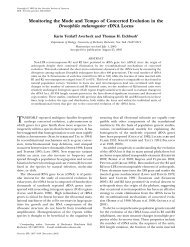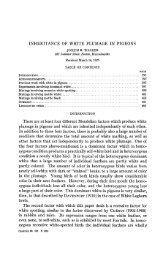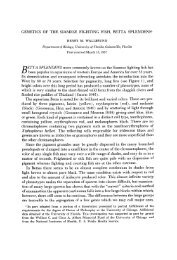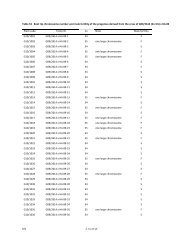abstracts of papers presented at the 1962 meetings - Genetics
abstracts of papers presented at the 1962 meetings - Genetics
abstracts of papers presented at the 1962 meetings - Genetics
You also want an ePaper? Increase the reach of your titles
YUMPU automatically turns print PDFs into web optimized ePapers that Google loves.
ABSTRACTS 993<br />
body” is observed in meiosis <strong>of</strong> 19 species <strong>of</strong> Bromus, representing five sections <strong>of</strong> this genus. The<br />
nuclear body is first visible <strong>at</strong> pachytene, and remains visible for periods ranging from metaphase<br />
I to <strong>the</strong> quartet, <strong>the</strong> dur<strong>at</strong>ion varying from species to species. It decreases in size during l<strong>at</strong>er<br />
stages <strong>of</strong> meiosis. The nuclear body is included in <strong>the</strong> prometaphase clump, is excluded from <strong>the</strong><br />
spindle, and is generally loc<strong>at</strong>ed near <strong>the</strong> pole <strong>at</strong> metpahase I; it does not divide, and is included<br />
in only one cell <strong>of</strong> <strong>the</strong> dyad and one cell <strong>of</strong> <strong>the</strong> quartet. This structure varies markedly in size<br />
among species <strong>of</strong> Bromus; <strong>the</strong>re is some rel<strong>at</strong>ionship, though not a precise one, between its size<br />
and <strong>the</strong> chromosome number. The nuclear body appears to consist <strong>of</strong> numerous small, thin-<br />
walled globules or <strong>of</strong> rel<strong>at</strong>ively few thick-walled globules, or a combin<strong>at</strong>ion <strong>of</strong> <strong>the</strong> two. The<br />
nuclear body is not associ<strong>at</strong>ed with <strong>the</strong> nucleolus, nor with <strong>the</strong> nucleolar organizing regions <strong>of</strong><br />
chromosomes. It is sometimes in contact with a bivalent <strong>at</strong> pachytene, and this may involve a<br />
terminal, subterminal or interstitial region, and sometimes bivalents with different chromomere<br />
p<strong>at</strong>terns. The nuclear body is more <strong>of</strong>ten in contact with bivalents in some species than in<br />
o<strong>the</strong>rs; thus <strong>the</strong> contacts may not be entirely fortuitous. The nuclear body has not to d<strong>at</strong>e been<br />
observed in mitotic cells. Its chemical constitution is now being investig<strong>at</strong>ed.<br />
WEILER, CONRAD P., City <strong>of</strong> Hope Medical Center, Duarte, Calif.: Sex chromosome behavior<br />
<strong>of</strong> amphibians. I. Ram pipiens-Genetic studies and breeding experiments on fishes, amphibians,<br />
and reptiles have shown <strong>the</strong> sex-determining mechanism to be ei<strong>the</strong>r <strong>the</strong> XY-XX type<br />
(male heterogamety) or <strong>the</strong> ZZ-ZW type (female heterogamety). Studies also showed many<br />
similarities in genetic constitution between <strong>the</strong> X and <strong>the</strong> Y, or <strong>the</strong> Z and <strong>the</strong> W. Cytological<br />
studies reported so far support <strong>the</strong> rel<strong>at</strong>ively undifferenti<strong>at</strong>ed st<strong>at</strong>e <strong>of</strong> <strong>the</strong> sex chromosomes <strong>of</strong><br />
lower vertebr<strong>at</strong>es.-In order to elucid<strong>at</strong>e <strong>the</strong> mechanism which prevents extensive crossing-over<br />
between <strong>the</strong> female-determining X and <strong>the</strong> male-determining Y during meiosis <strong>of</strong> <strong>the</strong> heterogametic<br />
sex, mitotic and meiotic figures <strong>of</strong> <strong>the</strong> leopard frog were studied.-Alignments <strong>of</strong><br />
metaphase chromosomes from Rana pipiens show th<strong>at</strong> both sexes have 13 identical pairs; thus<br />
<strong>the</strong> X and Y are morphologically identical. During sperm<strong>at</strong>ogenesis, no particular pair <strong>of</strong><br />
chromosomes exhibits positive heteropycnosis as does <strong>the</strong> mammalian sex pair, but chiasma frequency<br />
for all bivalents is definitely lower in males than in females. Since isol<strong>at</strong>ion <strong>of</strong> factors<br />
determining opposing sexes is crucial to <strong>the</strong> preserv<strong>at</strong>ion <strong>of</strong> a genetic sex-determining mechanism,<br />
it is proposed th<strong>at</strong> in Rana pipiens <strong>the</strong> isol<strong>at</strong>ion is accomplished by <strong>the</strong> lower chiasma r<strong>at</strong>e observed<br />
during meiosis in <strong>the</strong> heterogametic male. (This work supported in part by PHS grant<br />
CRT-5089.)<br />
WEIR, J. A., and G. SCHLAGER,<br />
University <strong>of</strong> Kansas, Lawrence, Kansas: Selection for total<br />
leucocyte count in <strong>the</strong> house mouse.-A high leucocyte line (LCH) and a low line (LCL) were<br />
selected from an outbred strain design<strong>at</strong>ed T. Selection was continuous for 25 gener<strong>at</strong>ions and<br />
was based on family and individual merit coupled with intensive inbreeding (mostly full-sib<br />
m<strong>at</strong>ings). Selection was effective from <strong>the</strong> onset with a maximum difference <strong>of</strong> over 100 percent<br />
<strong>of</strong> <strong>the</strong> original leucocyte number by gener<strong>at</strong>ion 13 (LCH 17,500, LCL 4,000 cells per nun3).-<br />
Although <strong>the</strong> selection differential was uniform in <strong>the</strong> two lines, <strong>the</strong> intensity <strong>of</strong> response was<br />
gre<strong>at</strong>er in <strong>the</strong> LCH with <strong>the</strong> initial number <strong>of</strong> leucocytes doubled by gener<strong>at</strong>ion 13. Response<br />
in <strong>the</strong> LCL was more gradual but continued until <strong>the</strong> end <strong>of</strong> <strong>the</strong> experiment. The asymmetry<br />
<strong>of</strong> response was st<strong>at</strong>istically significant. Leucocyte counts in <strong>the</strong> T strain corresponding to gen-<br />
er<strong>at</strong>ions 2, 5, 7, IO, and 16 remained rel<strong>at</strong>ively constant to gener<strong>at</strong>ion 10 (mean 8590) but<br />
dropped to 5105 in gener<strong>at</strong>ion 16. The downward trend in <strong>the</strong> three lines after gener<strong>at</strong>ion 13<br />
may be due to environmental factors. Ninety-five percent confidence limits set to <strong>the</strong> estim<strong>at</strong>e <strong>of</strong><br />
realized heritability for <strong>the</strong> first 13 gener<strong>at</strong>ions were 14.7 and 22.7 percent. The selected lines<br />
did not differ significantly in two components <strong>of</strong> fitness measured: numbers <strong>of</strong> progeny born or<br />
weaned, and weaning weight.-Leucocyte numbers confer resistance to irradi<strong>at</strong>ion, but not to<br />
artificial infection with mouse typhoid. The LCH and LCL strains were both more susceptible to





